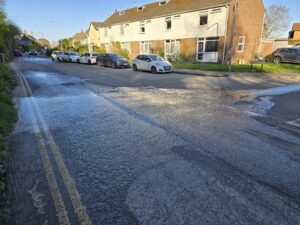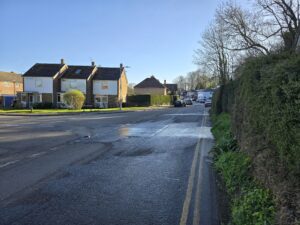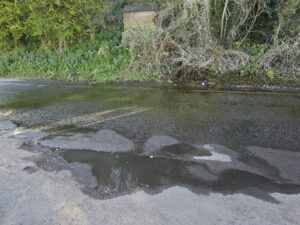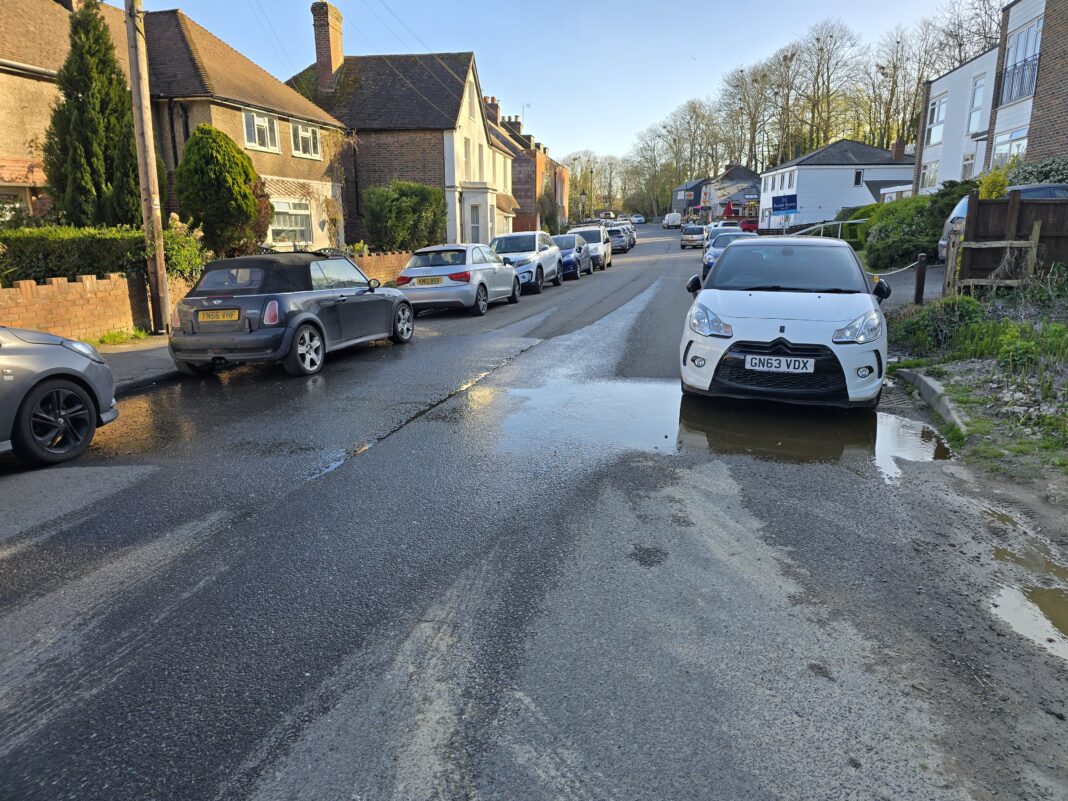Work to see whether the drainage system around Military Road in Rye can cope with heavy rain has been taking place since the beginning of March. Concerns have been raised about the amount of water in the road, fourteen months after the first of several recent landslips in the area.
At the recent Rye annual town meeting, Margaret O’Neill asked about water spillage on Military Road. She reported that residents are worried that water flows across the road all year round.
The water on Military Road, and occasionally in the North Salts, results from the natural springs and underground water sources that leak out of the escarpment along the north side and overloads or bypasses the road drains. The drains are not linked by any sort of roadside gully, which used to exist in the past.

From Tudor times, this water was captured and directed through pipes to supply the local water system. More in this Rye News article from 2015.
Why is there so much water?
Rainwater infiltrates into the ground and recharges aquifers in the Hastings Group of bed rock and sands to the north of Rye. As these aquifers become saturated, ground water pressure and levels rise, leading to a high discharge rate from the springs along the escarpments on the north edge of the town. There are several springs along the north side of the Military Road, a clue is in the naming of “Spring terrace” at the west end of the road.

The UK is experiencing more rain on average throughout the whole year – about 7 percent more over the past 30 years according to the Met Office. September 2024 was one of the wettest months in parts of England. In Sussex, weather stations recorded 154mm of rain across the month (three times the average). The mean for the whole year was around 700mm. The Met Office expects that in future more frequent extreme rainfall events can be expected. This will fill the aquifers and increase egress via springs. In turn this could also lead to more land instability events and surface water flooding.
What is being done?
Specifically for surface water, there is an investigation in New England Lane and Military Road by Balfour Beatty, working in partnership with East Sussex County Council, which started on March 6 2025. These works involve CCTV surveys of the underground drainage system and the use of high pressure water jets to clear the pipework. Balfour Beatty has approval for the works under Permit Reference – EA002J-MILITARY-RD-A-02 and EA002J-MILITARY-RD-B-01.
https://live.eastsussexhighways.com/highway-schemes/c296-military-road-rye-site-investigation-works
This investigation should identify whether the drains in Military Road have sufficient capacity to collect all the road surface water and dispose of it in a controlled manner to minimize damage.
However, from local examinations it is already clear that the drains on the north side of Military Road do not collect the large amounts of water spilling from the escarpment onto the edge of the road. There is no road side gully to collect any surface water and feed it into the drainage system. Recent images show multiple flows across the road surface which can cause a driving hazard and be an irritation to residents.
Once the Balfour Beatty investigation has been completed it will be helpful to have the report in the public domain so that local residents know more about the issues.

At the town meeting, Hastings and Rye MP Helena Dollimore suggested that she would be convening a meeting of experts to consider land instability and impact of flood risk in the Rye area. This would be a welcome and valuable exercise.
Image Credits: Anthony Kimber .




Very good news! We have been asking for action on this problem since last autumn. The amount of water coming down the hillside since last year’s landslips has seriously degraded the road surface, to the point where spot-patching of the tarmac will no longer do much good—the entire roadbed, at several points, needs to be rebuilt. Once the drains are sorted, of course.
Lets hope it gets sorted asap